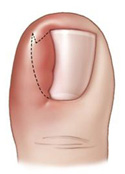Ingrown Toenail Treatment
For those dealing with the discomfort of ingrown toenails, finding the right treatment is essential. Dr. Daniel Bank specializes in comprehensive solutions for ingrown toenail issues, including removal, treatment, and surgery. Our podiatry services cover a range of treatments, including ingrown toenail removal, ingrown toenail treatment, infected ingrown toenail care, and surgical interventions for persistent cases like ingrown toenail surgery.
If you’re experiencing symptoms like inflammation, swelling, pain, or discharge, it’s crucial to seek treatment promptly to prevent further complications. Dr. Bank understands the impact that ingrown toenails can have on your daily life, which is why he provides compassionate and expert care to address these issues effectively.
We know how frustrating and uncomfortable ingrown toenails can be, and we’re here to help you find relief. Don’t let ingrown toenails hold you back any longer. Call us a (714) 434-1776 to schedule an appointment with Dr. Daniel Bank today and take the first step towards comfort and confidence in your feet.
Non-Surgical Treatment for Ingrown Toenails
Ingrown toenails should be treated as soon as they are recognized. If they are recognized early (before infection sets in), home care may prevent the need for further treatment:
- Soak the foot in warm water 3-4 times daily.
- Keep the foot dry during the rest of the day.
- Wear comfortable shoes with adequate room for the toes. Consider wearing sandals until the condition clears up.
- You may take ibuprofen or acetaminophen for pain relief.
- If there is no improvement in 2-3 days, or if the condition worsens, call your doctor.
You may need to gently lift the edge of the ingrown toenail from its embedded position and insert some cotton or waxed dental floss between the nail and your skin. Change this packing every day.
Symptoms of Ingrown Toenails
 When you first have an ingrown toenail, it may be hard, swollen and tender. Later, it may get red and infected, and feel very sore. Ingrown toenails are a common, painful condition—particularly among teenagers. Any of your toenails can become ingrown, but the problem more often affects the big toe. An ingrown nail occurs when the skin on one or both sides of a nail grows over the edges of the nail, or when the nail itself grows into the skin. Redness, pain and swelling at the corner of the nail may result and infection may soon follow. Sometimes a small amount of pus can be seen draining from the area.
When you first have an ingrown toenail, it may be hard, swollen and tender. Later, it may get red and infected, and feel very sore. Ingrown toenails are a common, painful condition—particularly among teenagers. Any of your toenails can become ingrown, but the problem more often affects the big toe. An ingrown nail occurs when the skin on one or both sides of a nail grows over the edges of the nail, or when the nail itself grows into the skin. Redness, pain and swelling at the corner of the nail may result and infection may soon follow. Sometimes a small amount of pus can be seen draining from the area.
Ingrown nails may develop for many reasons. Some cases are congenital—the nail is just too large for the toe. Trauma, such as stubbing the toe or having the toe stepped on, may also cause an ingrown nail. However, the most common cause is tight shoe wear or improper grooming and trimming of the nail.
Causes of Ingrown Toenails
Gout usually starts with a sudden onset of intense pain in one or more joints, usually the big toe joint of the foot. The pain is accompanied by redness, swelling and warmth over the joint. Typically, the patient does not recall injuring the joint before the pain started. Many patients say they first noticed pain in the middle of the night or upon arising in the morning.
While symptoms most commonly occur in the big toe joint, any joint may be involved. Other common sites are the instep of the foot, the ankle, or the knee. When the foot is involved, wearing shoes is difficult and painful, as are attempts to move the joint or stand on the foot.
How to Fix Ingrown Toenails
Suffering from the discomfort of ingrown toenails can be a frustrating experience. Dr. Daniel Bank specializes in providing comprehensive solutions for ingrown toenail issues, offering treatments ranging from removal to surgical intervention. If you’re experiencing symptoms like inflammation, swelling, or pain, prompt treatment is essential to prevent further complications. Don’t let ingrown toenails disrupt your daily life any longer. Call us at (714) 434-1776 to schedule an appointment with Dr. Bank today and take the first step towards relief and comfort in your feet.
